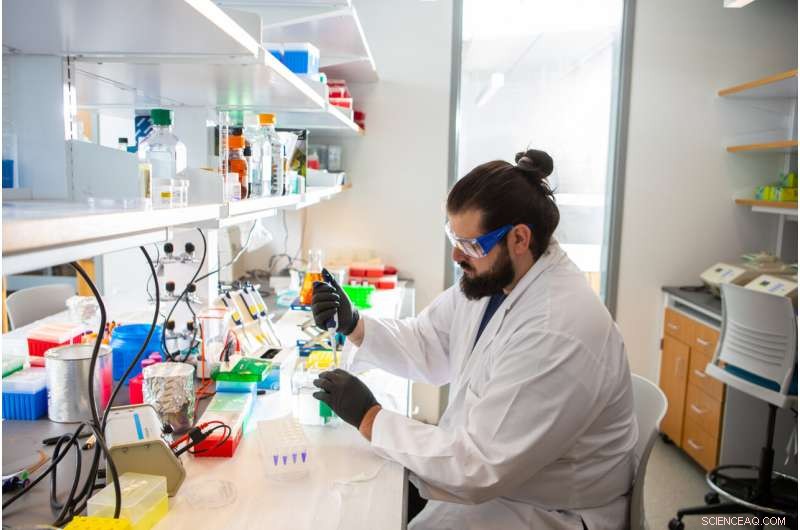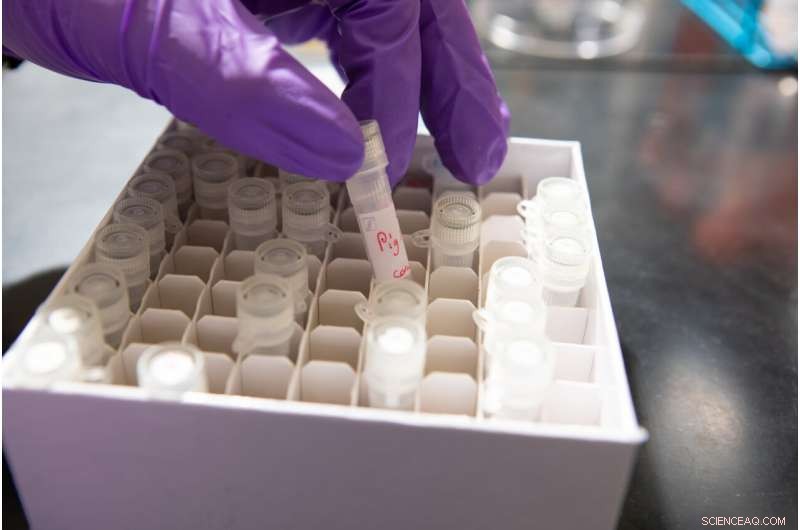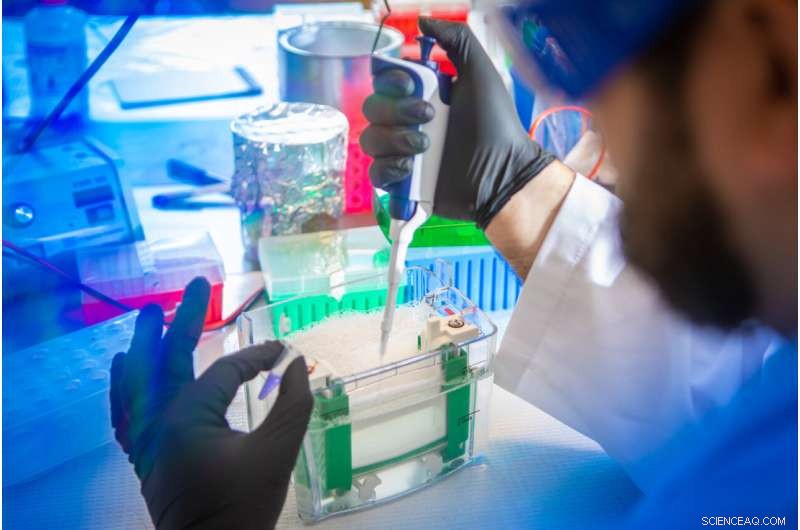
Petar Pajic, estudiante de doctorado en ciencias biológicas de la UB, prepara una muestra de saliva para su separación y análisis. En el nuevo estudio, el equipo utilizó una técnica de electroforesis en gel para separar las mucinas de otras proteínas en la saliva de varios mamíferos. Crédito:Douglas Levere/Universidad de Buffalo
Desde las babosas que recubren la baba hasta la saliva en la boca, muchos fluidos corporales resbaladizos contienen mucosidad. Entonces, ¿cómo evolucionó esta maravilla de la biología?
En los mamíferos, la respuesta es muchas veces, y a menudo de manera sorprendente, según un nuevo estudio sobre proteínas llamadas mucinas. Estas moléculas tienen una variedad de funciones, pero como familia, se las conoce como componentes de la mucosidad, donde contribuyen a la consistencia pegajosa de la sustancia.
A través de una comparación de genes de mucina en 49 especies de mamíferos, los científicos identificaron 15 casos en los que las nuevas mucinas parecen haber evolucionado a través de un proceso aditivo que transformó una proteína que no es mucina en una mucina.
Los científicos proponen que cada uno de estos eventos de "mucinización" comenzó con una proteína que no era una mucina. En algún momento, la evolución agregó una nueva sección a esta base sin mucina:una que consiste en una cadena corta de bloques de construcción llamados aminoácidos que están decorados con moléculas de azúcar. Con el tiempo, esta nueva región se duplicó, con múltiples copias añadidas para alargar aún más la proteína, convirtiéndola en una mucina.
Las regiones duplicadas, llamadas "repeticiones", son clave para la función de una mucina, dicen los investigadores de la Universidad de Buffalo Omer Gokcumen y Stefan Ruhl, los autores principales del estudio, y Petar Pajic, el primer autor.
Los azúcares que recubren estas secciones sobresalen como las cerdas de un cepillo para biberones y otorgan a las mucinas la propiedad viscosa que es vital para muchas tareas importantes que llevan a cabo estas proteínas.
La investigación se publicará el 26 de agosto en Science Advances.

Viales de saliva recolectados de varios mamíferos, incluido un cerdo. Crédito:Douglas Levere/Universidad de Buffalo
"No creo que se supiera previamente que la función de la proteína puede evolucionar de esta manera, de una proteína que gana secuencias repetidas. Una proteína que no es una mucina se convierte en una mucina simplemente ganando repeticiones. Esta es una forma importante en que la evolución hace que el limo . Es un truco evolutivo, y ahora documentamos que esto sucede una y otra vez", dice Gokcumen, Ph.D., profesor asociado de ciencias biológicas en la Facultad de Artes y Ciencias de la UB.
"Las repeticiones que vemos en las mucinas se denominan 'repeticiones de PTS' por su alto contenido de los aminoácidos prolina, treonina y serina, y ayudan a las mucinas en sus importantes funciones biológicas que van desde lubricar y proteger las superficies de los tejidos hasta ayudar a que nuestros alimentos sean resbaladizos para que podamos tragarlo", dice Stefan Ruhl, DDS, Ph.D., decano interino de la Facultad de Medicina Dental de la UB y profesor de biología oral. "Los microbios beneficiosos han evolucionado para vivir en superficies recubiertas de mucosidad, mientras que la mucosidad también puede actuar como una barrera protectora y defenderse de enfermedades al protegernos de intrusos patógenos no deseados".
"Not many people know that the first mucin which had been purified and biochemically characterized came from a salivary gland," Ruhl adds. "My lab has been studying mucins in saliva for the last 30 years, mostly because they protect teeth from decay and because they help balance the microbiota in the oral cavity."
The intriguing evolution of an 'amazing life trait'
"I think this paper is really interesting," Gokcumen says. "It's one of those times where we got lucky. We were studying saliva, and then we found something that's interesting and cool and decided to look into it."
While studying saliva, the team noticed that a small salivary mucin in humans called MUC7 was not present in mice. The rodents did, however, have a similarly sized salivary mucin called MUC10. The scientists wanted to know:Were these two proteins related from an evolutionary perspective?
The answer was no. But what the research uncovered next was a surprise. While MUC10 did not appear to be related to MUC7, a protein found in human tears called PROL1 did share a portion of MUC10's structure. PROL1 looked a lot like MUC10, minus the sugar-coated bottlebrush repeats that make MUC10 a mucin.

Petar Pajic, UB PhD student in biological sciences, uses a gel electrophoresis technique to separate mucins from other proteins in a saliva sample. Credit:Douglas Levere / University at Buffalo
"We think that somehow that tear gene ends up repurposed," Gokcumen says. "It gains the repeats that give it the mucin function, and it's now abundantly expressed in mouse and rat saliva."
The scientists wondered whether other mucins might have formed the same way. They began to investigate and discovered multiple examples of the same phenomena. Though many mucins share common ancestry among various groups of mammals, the team documented 15 instances in which evolution appeared to have converted non-mucin proteins into mucins via the addition of PTS repeats.
And this was "with a pretty conservative look," Gokcumen says, noting that the study focused on one region of the genome in a few dozen mammal species. He calls slime an "amazing life trait," and he's curious whether the same evolutionary mechanism might have driven the formation of some mucins in slugs, slime eels and other critters. More research is needed to find an answer.
"How new gene functions evolve is still a question we are asking today," says Pajic, a UB Ph.D. student in biological sciences. "Thus, we are adding to this discourse by providing evidence of a new mechanism, where gaining repeated sequences within a gene births a novel function."
"I think this could have even broader implications, both in understanding adaptive evolution and in possibly explaining certain disease-causing variants," Pajic adds. "If these mucins keep evolving from non-mucins over and over again in different species at different times, it suggests that there is some sort of adaptive pressure that makes it beneficial. And then, at the other end of the spectrum, maybe if this mechanism goes 'off the rails'—happening too much, or in the wrong tissue—then maybe it can lead to disease like certain cancers or mucosal illnesses."
The study on mucins demonstrates how a long-time partnership between evolutionary biologists and dental researchers at UB is yielding new insights into genes and proteins that are also important to human health.
"My team has been studying mucins for many decades, and my collaboration with Dr. Gokcumen has brought this research to a new level by revealing all these exciting novel insights into their evolutionary genetics," Ruhl says. "At this advanced stage of my career, it is also immensely gratifying to see that the flame of scientific curiosity is being carried on by a new generation of young investigators like Petar Pajic." Contact lenses:A molecule from pig stomach mucus prevents corneal damage